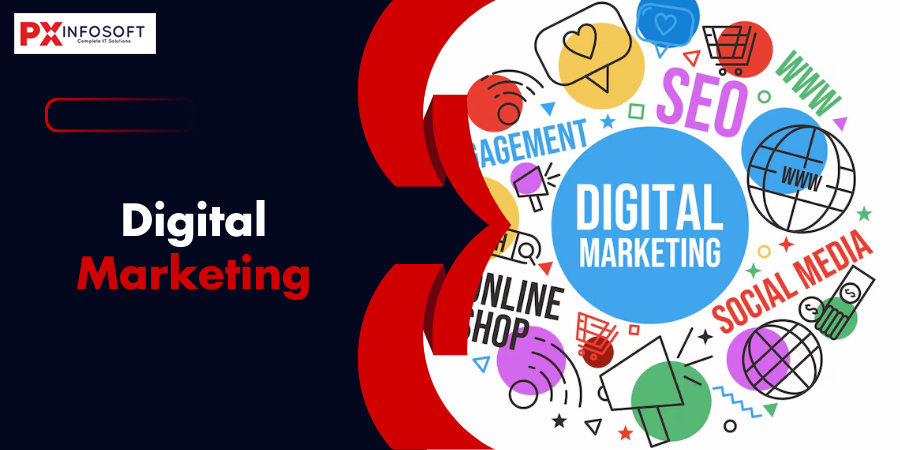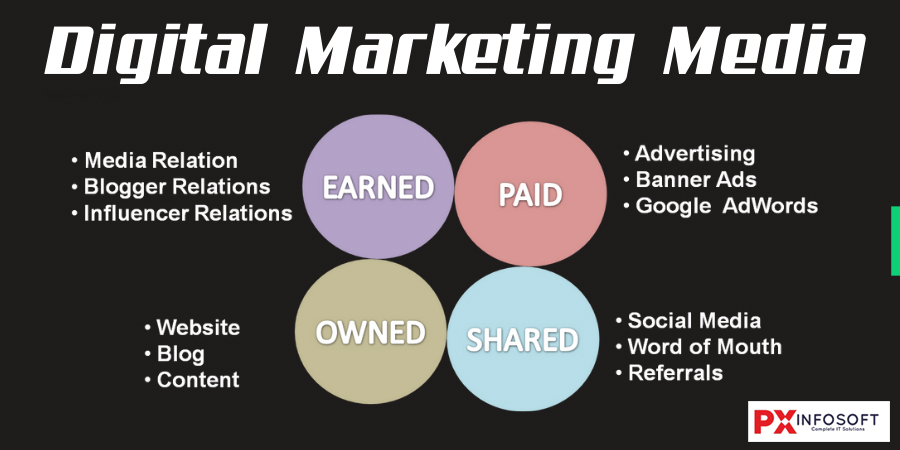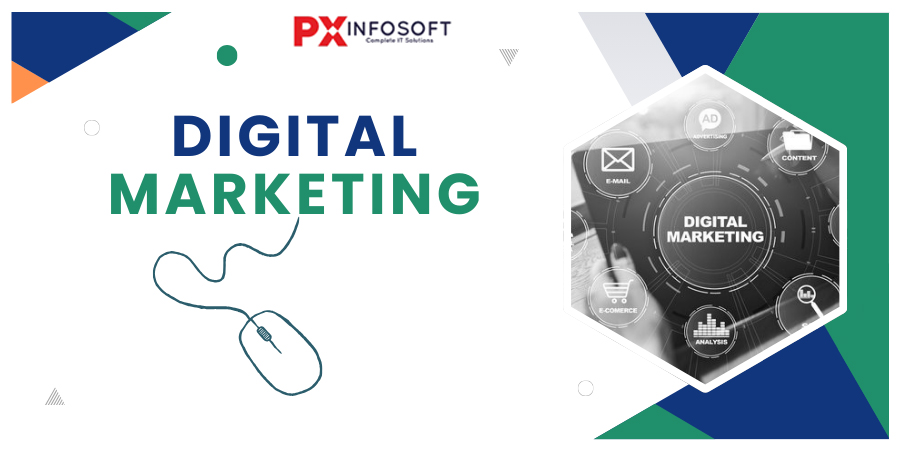In today’s fast-paced world, businesses need to adapt to the digital era to remain competitive. Digital marketing has evolved beyond a mere buzzword; it is now central to how companies connect with customers, boost sales, and enhance their brand. Thanks to the internet and mobile technologies, businesses of all sizes can now engage with a global audience in real-time. However, to thrive, it’s crucial to grasp the true essence of digital marketing and develop effective strategies. In this blog post, we will explore the realm of digital marketing, examine various channels and strategies, and emphasize the importance of keeping up with trends in the digital landscape.
What is Marketing
Marketing encompasses the various activities a company engages in to encourage the purchase or sale of its products or services. It includes advertising and enables businesses to reach consumers, other businesses, and organizations. At its core, marketing involves planning and implementing strategies for the development, pricing, distribution, and promotion of products and services, all aimed at meeting customer needs. The primary goal of marketing is to provide value to customers, attract new ones, and retain existing ones.
How Marketing Works?
Marketing serves to enhance brand awareness and generate leads that can ultimately convert into sales. Various strategies are employed, including digital marketing, where companies utilize platforms like Instagram, Facebook, Google, and their own websites. To attract leads, a company might conduct quarterly campaigns across these channels.
- Prepare a mission statement.
- Determine your audience.
- Describe your services.
- Spell out marketing and promotional strategies.
- Know your competitors.
- Establish marketing goals that are quantifiable.
- Monitor your results.
What is Digital Marketing?

Digital marketing encompasses all marketing activities that leverage the internet or electronic devices to promote products or services. Unlike traditional marketing, it focuses on utilizing online platforms and digital tools to engage potential customers. This broad term includes various strategies such as content marketing, search engine optimization (SEO), email marketing, social media marketing, online advertising, and more. In simpler terms, digital marketing, often referred to as online marketing, is about promoting brands to connect with potential customers through the internet and other digital communication methods. This approach includes not just email, social media, and web-based advertising, but also text messages and multimedia content as marketing channels.
History of Digital Marketing
The Father of Digital Marketing, Philip Kotler, was born on May 27, 1931, in Chicago, Illinois. He is often referred to as the “Father of Digital Marketing.”
The term “Digital Marketing” emerged in the 1990s, coinciding with the rise of the internet and the introduction of the Web 1.0 platform. This platform enabled users to access information but did not facilitate sharing it online. At that time, marketers around the globe were still uncertain about the digital landscape and whether their strategies would be effective, as the internet had not yet become widely adopted.
In 1993, the first clickable banner ad was launched, leading HotWired to purchase several banner ads for their advertising campaigns. The year 1994 saw new technologies enter the digital marketplace. The very same year, Yahoo was launched. 1998 saw the birth of Google. Microsoft launched the MSN search engine and Yahoo brought to the market Yahoo web search.
| Year | Evolution |
| 1990 | Static Display Ads |
| 1993 | First Clickable Ad |
| 1998 | First Search Advertising Keywords |
| 2000 | Google AdWords Launched |
Digital Marketing Objectives
A primary objective of digital marketing is to increase traffic to a company’s website. By utilizing search engine optimization, engaging content, social media, and email marketing, businesses strive to draw relevant visitors to their sites. Digital marketing plays a crucial role in enhancing brand awareness and boosting product sales among both new and existing customers. A significant advantage of digital marketing is its ability to target specific audiences more effectively than traditional marketing, which tends to reach broader demographics.
- Increasing brand awareness:- Online marketing plays a crucial role in boosting brand visibility to the intended audience. This is accomplished through a range of digital platforms, including social media, content marketing, and display ads. Raising brand awareness involves not just making sure your target audience recognizes your name, but also earning their respect. One effective strategy to achieve both goals is to develop a thought leadership program that showcases the expertise of the individuals behind your brand.
- Driving website traffic:- Digital marketing addresses all your questions regarding boosting website traffic. Its goal is to draw in relevant and high-quality visitors to a company’s site. This is essential for generating leads, enhancing sales, and meeting various conversion goals. Visibility: Engaging posts can go viral, expanding visibility and connecting with new audiences. SEO Benefits: Links from social media can enhance search engine rankings. Targeted Ads: Paid advertisements on social media can be customized for specific demographics, directing relevant traffic to your website.
- Generating leads:- A key goal of online marketing is to gather contact information from potential customers and turn them into leads. This is done through various methods like lead magnets, opt-in forms, and other techniques to collect customer data. Lead generation refers to the process of sparking consumer interest in a product or service, aiming to convert that interest into sales. In the realm of online marketing, this usually means obtaining a visitor’s contact details (referred to as a “lead”) through a web form.
- Boosting sales and revenue:- Online marketing is crucial for boosting revenue and enhancing sales. Companies can elevate their sales figures by targeting the appropriate audience with the right message at the right moment. To increase sales through digital marketing, implement targeted social media campaigns, optimize your website for search engines, and leverage email marketing. Create compelling content that resonates with your audience, utilize pay-per-click advertising for immediate exposure, and apply data analytics to refine your strategies.
- Engaging with the target audience:- Online marketing enables a two-way conversation between businesses and their customers. It provides companies the opportunity to connect with their audience via social media, email marketing, and various interactive platforms. In the realm of digital marketing, audience engagement describes how actively a target audience interacts with a brand and its online content, which includes websites, social media, and online advertisements. This engagement is assessed through metrics such as the number of website visitors, the length of their visits, the pages they view, and the shares on social media, among other indicators.
- Building customer loyalty and retention:- The main aim of fostering customer loyalty and retention is to transform occasional buyers into committed, repeat customers who not only keep supporting your business but also become advocates, recommending your brand to others. Keeping existing customers is often more economical than bringing in new ones. Online marketing strategies can play a crucial role in nurturing long-term customer relationships, which in turn encourages repeat business and strengthens brand loyalty. Customer loyalty represents a continuous positive relationship between a customer and a business. It drives repeat purchases and influences existing customers to prefer your company over competitors that offer similar advantages. One way to understand loyalty is by considering it in the context of brand.
- Improving customer support:- Online marketing can significantly improve customer support and effectively address customer queries and concerns. Utilizing social media, chatbots, and email support are just a few methods to enhance customer service. To truly master the digital customer experience, it’s essential to have a well-rounded strategy that includes personalized communication, smooth integration across various channels, and ongoing optimization driven by customer feedback and data analytics.
- Conducting market research:- It offers important data and insights into customer behavior, trends, and preferences. This information can help refine marketing strategies and enhance market research efforts. Market research involves gathering essential details about a company’s target audience, market, and competitors. By conducting market research, businesses can gain a deeper understanding of their audience. This knowledge allows them to create better products, enhance user experiences, and develop marketing strategies that attract high-quality leads. Market research combines insights into consumer behavior and economic trends to validate and strengthen your business idea. Understanding your consumer base from the beginning is vital. Market research helps mitigate risks, even when your business is still just a concept.
- Competitor analysis:- A competitor analysis, often called a competitive analysis, involves identifying the competitors within your industry and examining their various marketing strategies. This information serves as a benchmark to help you pinpoint your company’s strengths and weaknesses in relation to each competitor. By utilizing online marketing tools, businesses can conduct a SWOT analysis to keep track of their competitors’ actions, evaluate their strengths and weaknesses, and modify their strategies as needed.
- How to do a competitive analysis
-
- Create a competitor overview.
- Conduct market research.
- Compare product features.
- Compare product marketing.
- Use a SWOT analysis.
- Identify your place in the market landscape.
-
- How to do a competitive analysis
- Expanded Social Media Presence and Followers:- Social networking platforms like Instagram, Facebook, and X represent significant consumer markets. As brands work to build trust and expand their reach, they can gain more followers and connect with a larger number of user accounts. Key elements such as a targeted social media marketing strategy, consistent content posting, engaging with users, and tracking user metrics play a vital role in achieving this digital marketing goal. Maintaining an active social media presence allows audiences to see your brand more frequently, which can enhance customer satisfaction and loyalty. This engagement might include sharing user-generated content and highlighting positive customer experiences. Additionally, you may want to capitalize on current trends or initiate your own viral campaigns.
- Global Reach:- One of the main benefits of digital marketing is its ability to reach a global audience. In contrast to traditional marketing, which often faces limitations due to geographical boundaries and can be expensive and labor-intensive to execute internationally, digital marketing thrives on the Internet. This enables even the smallest local businesses to engage with customers around the world through an online store. Achieving such a broad reach would be nearly impossible with traditional marketing methods without incurring hefty costs. The online accessibility has opened up numerous growth opportunities for businesses to explore. The combination of global reach and visibility offers an incredible chance for any business. Global Reach refers to a business’s effort to enhance the connection between a company and its current and potential customers by leveraging the Internet.
- Local Reach:- While the global reach of digital marketing is a significant advantage, it also boosts local visibility, which is essential for businesses that rely on customers in their vicinity. By leveraging local SEO and targeted advertisements, companies can effectively increase foot traffic. Think about how digital marketing can engage an entire neighborhood compared to the time and effort needed to print and distribute flyers. Local online marketing focuses on promoting to customers or potential customers within a specific geographic area. It employs various digital channels, including social media, search engines, email, and mobile apps, to connect with the target audience. Approximately 85% of all transactions take place in local stores.
- Cost-effective:- One major benefit of digital marketing is its affordability. Whether you’re aiming to promote your business locally or on a global scale, digital marketing provides cost-effective options. It allows even the smallest companies to compete with larger ones through precisely targeted strategies. Many of these approaches, such as SEO, social media, and content marketing, can be initiated with little to no financial investment. However, it’s crucial to recognize that not every form of digital marketing suits every business, and some may involve higher expenses than others. Companies can determine the most effective solutions based on their unique marketing goals. With digital marketing, many of your expenses are minimal. For instance, email campaigns, social media engagement, and website content are almost free to create. When customers connect with you through these channels, your customer acquisition cost is very low.
Digital Marketing Media

- EARNED
- Media Relation
- Blogger Relations
- Influencer Relations
- PAID
- Advertising
- Banner Ads
- Google AdWords
- SHARED
- Social Media
- Word of Mouth
- Referrals
- OWNED
- Website
- Blog
- Content
Key Digital Marketing Strategies
Now that we understand what digital marketing is and why it’s essential, let’s dive into the various strategies used to achieve success in this space:
Search Engine Optimization (SEO)
SEO is the process of optimizing your website so that it ranks higher on search engines like Google, Bing, and Yahoo. The higher your site ranks in search results, the more likely it is that users will click on it. SEO involves two main components:
- On-Page SEO:- This refers to optimizing elements within your website such as content, meta tags, images, and internal links. Proper use of keywords, a clean website structure, and engaging content are key factors.
- Off-Page SEO:- This focuses on activities outside of your website, like building backlinks from other trusted websites. The more reputable the sources linking to your site, the higher your domain authority and search engine rankings will be.
Effective SEO requires a combination of technical expertise, content strategy, and analytics. The goal is to appear at the top of the search engine results page (SERP) for keywords related to your business.
Content Marketing
Content marketing is the creation and distribution of valuable, relevant content designed to attract and engage your target audience. This strategy is critical for building trust and authority in your industry. Types of content you can produce include:
- Blog Posts:- Articles or posts that provide useful information or solve a problem for your target audience.
- Videos:- Short-form or long-form videos can help convey complex messages or showcase your products in action.
- Infographics:- Visual content that simplifies information and makes it easier to understand.
- Podcasts:- Audio content that can offer in-depth interviews, industry insights, or entertainment.
The key to content marketing is creating content that aligns with the interests and needs of your target audience. When done correctly, content marketing helps drive organic traffic to your site, improves brand visibility, and increases conversions.
Social Media Marketing
Social media platforms like Facebook, Instagram, Twitter, LinkedIn, and TikTok are some of the most powerful tools for engaging with potential customers. Social media marketing involves:
- Building a Community:- Create and nurture a loyal following by sharing valuable content, responding to comments, and engaging in conversations.
- Paid Advertising:- Platforms like Facebook and Instagram allow you to run paid ads that target specific demographics based on interests, behaviors, and location.
- Influencer Marketing:- Partnering with influencers who have a significant following in your niche can help build brand awareness and credibility.
Social media is also a great place to gather customer feedback, conduct surveys, and understand your audience’s preferences.
Email Marketing
Email marketing remains one of the most effective channels for direct communication with customers. With a well-crafted email campaign, you can:
- Promote Products and Services:- Send out promotional emails, product launches, or special discounts.
- Nurture Leads:- Build relationships with potential customers by providing them with helpful content and keeping them engaged with your brand.
- Personalization:- Tailor your emails to suit the interests of your audience, increasing the chances of conversion.
With tools like Mailchimp, ConvertKit, and others, businesses can segment their email list and send targeted messages that improve engagement rates and ROI.
Paid Advertising (PPC)
Paid advertising, or pay-per-click (PPC) advertising, is when businesses pay a fee each time their ad is clicked. PPC ads can appear on search engines (Google Ads), social media platforms (Facebook Ads), or websites (display ads). Some of the most popular types of paid advertising include:
- Search Ads:- Text-based ads that appear at the top of search engine results when someone searches for a relevant keyword.
- Display Ads:- Banner ads or image-based ads that appear on websites within the Google Display Network.
- Social Media Ads:- Paid ads that appear on social platforms like Facebook, Instagram, and LinkedIn.
PPC is a great way to get quick results and drive traffic to your website. However, it requires constant optimization and monitoring to ensure a high return on investment (ROI).
Affiliate Marketing
Affiliate marketing involves partnering with influencers, bloggers, or other businesses to promote your products or services in exchange for a commission. This can be a cost-effective way to drive sales, especially if you partner with affiliates who already have a significant following in your niche. Affiliate marketing is often used in eCommerce and can work well for businesses in various industries, from fashion to software services.
Online Reputation Management (ORM)
In the digital age, a company’s reputation is its most valuable asset. Online reputation management involves monitoring and improving the perception of your business online. This strategy includes:
- Responding to Reviews:- Engaging with customers who leave reviews (both positive and negative) helps build trust and loyalty.
- Managing Social Media Presence:- Ensure your social media profiles reflect your brand’s values and engage with customers in a meaningful way.
- Addressing Negative Content:- Take proactive measures to suppress or correct negative online content that could harm your brand.
Trends in Digital Marketing for 2025
The digital marketing landscape is always evolving, and businesses must adapt to the latest trends to remain competitive. Here are some trends to watch for in 2025:
- AI and Automation:- AI-powered tools for customer support, chatbots, and data analysis will continue to grow in importance.
- Video Marketing:- Short-form videos, live streaming, and interactive video content will dominate digital marketing strategies.
- Voice Search Optimization:- With the rise of voice assistants like Alexa and Siri, businesses will need to optimize content for voice search.
- Personalization:- Consumers increasingly expect tailored experiences. Marketers will continue to use data to provide personalized content, ads, and offers.
- Sustainability Marketing:- As consumers become more eco-conscious, businesses will need to demonstrate their commitment to sustainability.
Conclusion
Digital marketing is an essential component of any modern business strategy. With the right mix of SEO, content marketing, social media engagement, email campaigns, and paid advertising, businesses can reach a larger audience, build stronger relationships with customers, and boost their revenue. As digital trends continue to evolve, staying up to date with the latest technologies and strategies will be crucial for long-term success.
By understanding and leveraging the power of digital marketing, you can position your business for growth and remain competitive in the ever-changing digital landscape.



